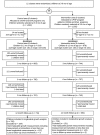Effectiveness of a community-based nutrition programme to improve child growth in rural Ethiopia: a cluster randomized trial
- PMID: 27549570
- PMCID: PMC6866137
- DOI: 10.1111/mcn.12349
Effectiveness of a community-based nutrition programme to improve child growth in rural Ethiopia: a cluster randomized trial
Abstract
Few trials have shown that promoting complementary feeding among young children is effective in improving child linear growth in resource-challenged settings. We designed a community-based participatory nutrition promotion (CPNP) programme adapting a Positive Deviance/Hearth approach that engaged mothers in 2-week nutrition sessions using the principles of 'learning by doing' around child feeding. We aimed to test the effectiveness of the CPNP for improving child growth in rural Ethiopia. A cluster randomized trial was implemented by adding the CPNP to the existing government nutrition programmes (six clusters) vs. government programmes only (six clusters). A total of 1790 children aged 6 to 12 months (876 in the intervention and 914 in the control areas) were enrolled and assessed on anthropometry every 3 months for a year. Multi-level mixed-effect regression analysis of longitudinal outcome data (n = 1475) examined the programme impact on growth, adjusting for clustering and enrollment characteristics. Compared with children 6 to 24 months of age in the control area, those in the intervention area had a greater increase in z scores for length-for-age [difference (diff): 0.021 z score/month, 95% CI: 0.008, 0.034] and weight-for-length (diff: 0.042 z score/month, 95% CI: 0.024, 0.059). At the end of the 12-month follow-up, children in the intervention area showed an 8.1% (P = 0.02) and 6.3% (P = 0.046) lower prevalence of stunting and underweight, respectively, after controlling for differences in the prevalence at enrollment, compared with the control group. A novel CPNP programme was effective in improving child growth and reducing undernutrition in this setting. © 2016 John Wiley & Sons Ltd.
Keywords: Ethiopia; childhood stunting; cluster randomized trial; community-based participatory nutrition promotion; complementary feeding practices; effectiveness evaluation.
© 2016 John Wiley & Sons Ltd.
Conflict of interest statement
Yunhee Kang and Parul Christian had no conflict of interest related to the study. Sungtae Kim is an employee of World Vision Korea. Sisay Sinamo is an employee of World Vision International.
Figures


References
-
- Aubela J., Toure I. & Diagne M. (2004) Senegalese grandmothers promote improved maternal and child nutrition practices: the guardians of tradition are not averse to change. Social Science & Medicine 59, 945–959. - PubMed
-
- Bhutta Z.A., Das J.K., Rizvi A., Gaffey M.F., Walker N., Horton S. et al. (2013) Evidence‐based interventions for improvement of maternal and child nutrition: what can be done and at what cost? Lancet 382, 452–477. - PubMed
-
- Bisits Bullen P.A. (2011) The positive deviance/hearth approach to reducing child malnutrition: systematic review. Tropical Medicine and International Health 16, 1354–1366. - PubMed
-
- Bolles K., Speraw C., Berggren G. & Lafontant J.G. (2002) Ti Foyer (hearth) community‐based nutrition activities informed by the positive deviance approach in Leongane, Haiti: A programmatic description. Food and Nutrition Bulletin 23 (suppl4), S9–S15. - PubMed
-
- Burkhalter B.R. & Northrup R.S. (1997) Hearth program at the hoˆpital Albert Schweitzer in Haiti In: Hearth Nutrition Model: Applications in Haiti, Vietnam, and Bangladesh (eds Wollinka O., Keeley E., Burkhalter B.R. & Bahir N.). Agency for International Development and World Relief Corporation by the Basic Support for Institutionalizing Child Survival (BASICS) Project: Arlington, U.S.
Publication types
MeSH terms
LinkOut - more resources
Full Text Sources
Other Literature Sources
Medical

